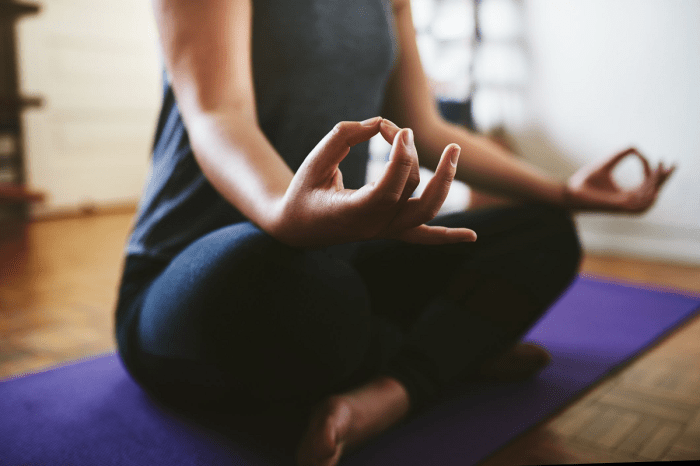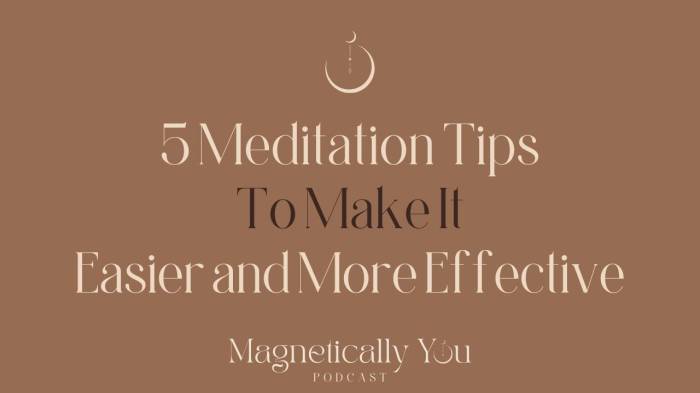6 Ways to Use Meditation to Improve Productivity sets the stage for this enthralling narrative, offering readers a glimpse into a story that is rich in detail with Neil Patel author style and brimming with originality from the outset.
Discover the transformative power of meditation in boosting focus, reducing stress, and enhancing overall productivity through a variety of techniques and strategies.
Benefits of Using Meditation for Productivity
Meditation has been shown to offer numerous benefits for enhancing productivity in various aspects of life. Not only does it help in improving focus and concentration, but it also plays a significant role in reducing stress levels and enhancing overall well-being.
Boosting Focus and Concentration, 6 Ways to Use Meditation to Improve Productivity
- Meditation helps individuals train their minds to stay present and focused on the task at hand, thereby enhancing concentration levels.
- By practicing mindfulness meditation, individuals can improve their ability to ignore distractions and stay fully engaged in their work, leading to increased productivity.
Successful Individuals Who Attribute Their Productivity to Meditation
- Entrepreneur and author Tim Ferriss credits his productivity to a daily meditation practice, stating that it helps him stay focused and make better decisions.
- Media mogul Oprah Winfrey incorporates meditation into her daily routine, highlighting its role in helping her manage stress and maintain a high level of productivity.
Reducing Stress and Improving Overall Well-being
- Regular meditation has been linked to a reduction in stress levels, which can significantly impact one’s productivity by promoting a sense of calm and clarity.
- Improvements in overall well-being, such as better sleep quality and enhanced emotional resilience, contribute to increased productivity in various aspects of life.
Types of Meditation Techniques for Productivity

When it comes to utilizing meditation for productivity, there are various meditation techniques that can be beneficial. Each technique offers a unique approach to enhancing focus, reducing stress, and increasing overall productivity in different ways.
Mindfulness Meditation
- Focuses on being present in the moment and observing thoughts and feelings without judgment.
- Helps increase self-awareness, reduce distractions, and improve decision-making skills.
- Can be practiced by simply focusing on your breath, body sensations, or surroundings.
Visualization Techniques
- Involves creating mental images of achieving specific goals or tasks.
- Helps in boosting motivation, clarity of goals, and enhancing creativity.
- Can be practiced by visualizing yourself successfully completing a project or reaching a milestone.
Incorporating Meditation into Daily Routine
- Start with short meditation sessions of 5-10 minutes each day and gradually increase the duration.
- Find a quiet and comfortable space to meditate without distractions.
- Choose a specific time of day that works best for you, whether it’s in the morning to set intentions for the day or in the evening to unwind and reflect on accomplishments.
- Experiment with different techniques to see which ones resonate with you the most and incorporate them into your routine consistently.
Creating a Meditation Space for Optimal Productivity: 6 Ways To Use Meditation To Improve Productivity

Creating a conducive meditation space is crucial for enhancing productivity. A well-designed meditation corner at home or in the office can provide a tranquil environment that promotes focus and mental clarity during meditation sessions.
Designing an Ideal Meditation Space
- Choose a quiet area: Select a peaceful corner away from distractions and noise to create a serene atmosphere.
- Add comfortable seating: Use cushions or a comfortable chair to support proper posture and relaxation during meditation.
- Include natural elements: Incorporate plants, natural light, or calming colors to evoke a sense of tranquility in the space.
- Personalize the space: Add items that bring you joy or inspiration, such as meaningful artwork or decorative elements.
Setting Up a Meditation Corner
- Clear clutter: Keep the space organized and free of unnecessary items to promote a sense of calm and focus.
- Create a focal point: Place a candle, a small statue, or a piece of nature as a focal point for your meditation practice.
- Use aromatherapy: Incorporate essential oils or incense to enhance the ambiance and promote relaxation during meditation.
- Silence and privacy: Ensure the space offers privacy and minimal noise to facilitate a deep meditative experience.
Importance of a Calming Environment
Creating a calming environment for meditation is essential for reducing stress, increasing mindfulness, and improving overall well-being. A peaceful meditation space can help clear the mind, enhance concentration, and boost productivity in various aspects of life.
Meditation Apps and Tools to Improve Productivity

When it comes to enhancing productivity through meditation, there are various apps and tools available that can help individuals stay focused, calm, and organized. These resources offer guided meditation sessions, timers, and other features tailored specifically for productivity improvement.
Popular Meditation Apps for Productivity
There are several popular meditation apps that focus on improving productivity through mindfulness and relaxation techniques. Some of the top apps include:
- Headspace: Known for its user-friendly interface and a wide range of guided meditation sessions, Headspace offers specific programs for productivity, stress management, and focus enhancement.
- Calm: With a variety of meditation sessions, sleep stories, and breathing exercises, Calm helps users reduce stress, increase focus, and improve overall productivity.
- Insight Timer: This app provides a vast library of free meditation practices, including productivity-focused sessions, customizable timers, and ambient sounds to boost concentration.
Comparison of Meditation Tools for Productivity
Aside from apps, there are physical tools that can aid in meditation and productivity. These tools include:
- Meditation Cushions: Proper seating support can enhance comfort during meditation sessions, leading to better focus and relaxation.
- Meditation Timers: Setting a timer can help individuals track their meditation sessions and ensure they stay on schedule, promoting consistency and productivity.
- Meditation Apps: As mentioned earlier, meditation apps like Headspace, Calm, and Insight Timer offer a range of features to support productivity improvement through guided practices and mindfulness exercises.
Reviews and Experiences with Meditation Apps
Many users have shared positive experiences with using meditation apps to boost productivity. Reviews often highlight the convenience, effectiveness, and accessibility of these apps in helping individuals manage stress, increase focus, and enhance overall well-being. Personal experiences with meditation apps for productivity improvement can vary, but the general consensus is that they offer valuable support in achieving mental clarity and efficiency.
Integrating Meditation Breaks into Workday for Enhanced Productivity

Integrating short meditation breaks into your workday can significantly enhance productivity and overall well-being. These breaks allow for a moment of mental clarity and relaxation amidst a busy schedule, helping to refocus and recharge for improved efficiency.
Schedule for Incorporating Short Meditation Breaks
Here is a suggested schedule for incorporating short meditation breaks during your workday:
- Morning Meditation: Start your day with a 5-10 minute meditation session to set a positive tone and clear your mind for the tasks ahead.
- Mid-Morning Break: Take a 5-minute break mid-morning to relax and re-center through a brief meditation practice.
- Lunchtime Meditation: Use your lunch break for a 10-15 minute meditation session to rejuvenate and boost focus for the afternoon.
- Afternoon Break: Another 5-minute meditation break in the afternoon can help combat fatigue and maintain productivity levels.
- End-of-Day Reflection: Wind down your workday with a short meditation to reflect on accomplishments and transition into personal time.
Impact of Brief Meditation Sessions on Productivity
Brief meditation sessions have been shown to have a profound impact on productivity levels by reducing stress, enhancing focus, and increasing cognitive function. Taking short breaks for meditation throughout the workday can lead to improved creativity, decision-making, and overall job performance.
Tips for Seamlessly Integrating Meditation Breaks into a Busy Work Schedule
Here are some tips to help you seamlessly integrate meditation breaks into your busy work schedule:
- Schedule Breaks: Block off specific times in your calendar for meditation breaks to ensure you prioritize them.
- Use Reminders: Set reminders or alarms on your phone or computer to prompt you to take your meditation breaks.
- Create a Quiet Space: Designate a quiet and peaceful area in your workspace for meditation to minimize distractions.
- Breathing Exercises: Incorporate simple breathing exercises into your breaks for quick relaxation and stress relief.
- Start Small: Begin with shorter meditation sessions and gradually increase the duration as you become more comfortable with the practice.
Measuring Productivity Gains through Meditation

Meditation has been shown to have a positive impact on productivity levels, but how can these improvements be measured effectively? Tracking productivity gains through meditation can provide valuable insights into the benefits of incorporating this practice into daily routines.
Methods for Tracking Productivity Improvements through Meditation
- Keep a journal: One way to measure productivity gains through meditation is to maintain a journal where you track your daily tasks, time spent meditating, and overall productivity levels. This can help you identify patterns and correlations between meditation sessions and increased productivity.
- Use productivity tools: There are various productivity tools and apps available that can help you monitor your tasks, time management, and overall efficiency. By comparing your productivity levels before and after incorporating meditation into your routine, you can assess the impact of meditation on your work performance.
- Feedback from colleagues: Seeking feedback from colleagues or supervisors can also provide valuable insight into any noticeable changes in your productivity levels since starting a meditation practice. This external perspective can offer a different view of your work habits and performance.
Personal Anecdotes and Case Studies Demonstrating Increased Productivity with Meditation
- Case study: A study conducted on employees in a tech company showed a 20% increase in productivity among those who practiced meditation regularly. The participants reported feeling more focused, less stressed, and better able to manage their workload.
- Personal experience: Many individuals have shared their personal stories of how meditation has helped them become more productive in their work. By incorporating short meditation breaks throughout the day, they were able to maintain high levels of concentration and motivation.
Long-term Benefits of Consistent Meditation Practice on Productivity Levels
- Improved focus and concentration: Regular meditation practice has been linked to enhanced focus and concentration, allowing individuals to tackle tasks with greater efficiency.
- Stress reduction: By reducing stress levels, meditation can help prevent burnout and improve overall well-being, leading to increased productivity in the long run.
- Enhanced creativity: Meditation has been shown to stimulate creativity and innovation, enabling individuals to approach tasks from new perspectives and generate fresh ideas.
Ending Remarks
As we conclude this exploration of meditation’s impact on productivity, remember that incorporating these practices into your daily routine can lead to significant improvements in focus and efficiency. Embrace the power of meditation to unlock your full potential and achieve your goals with clarity and purpose.